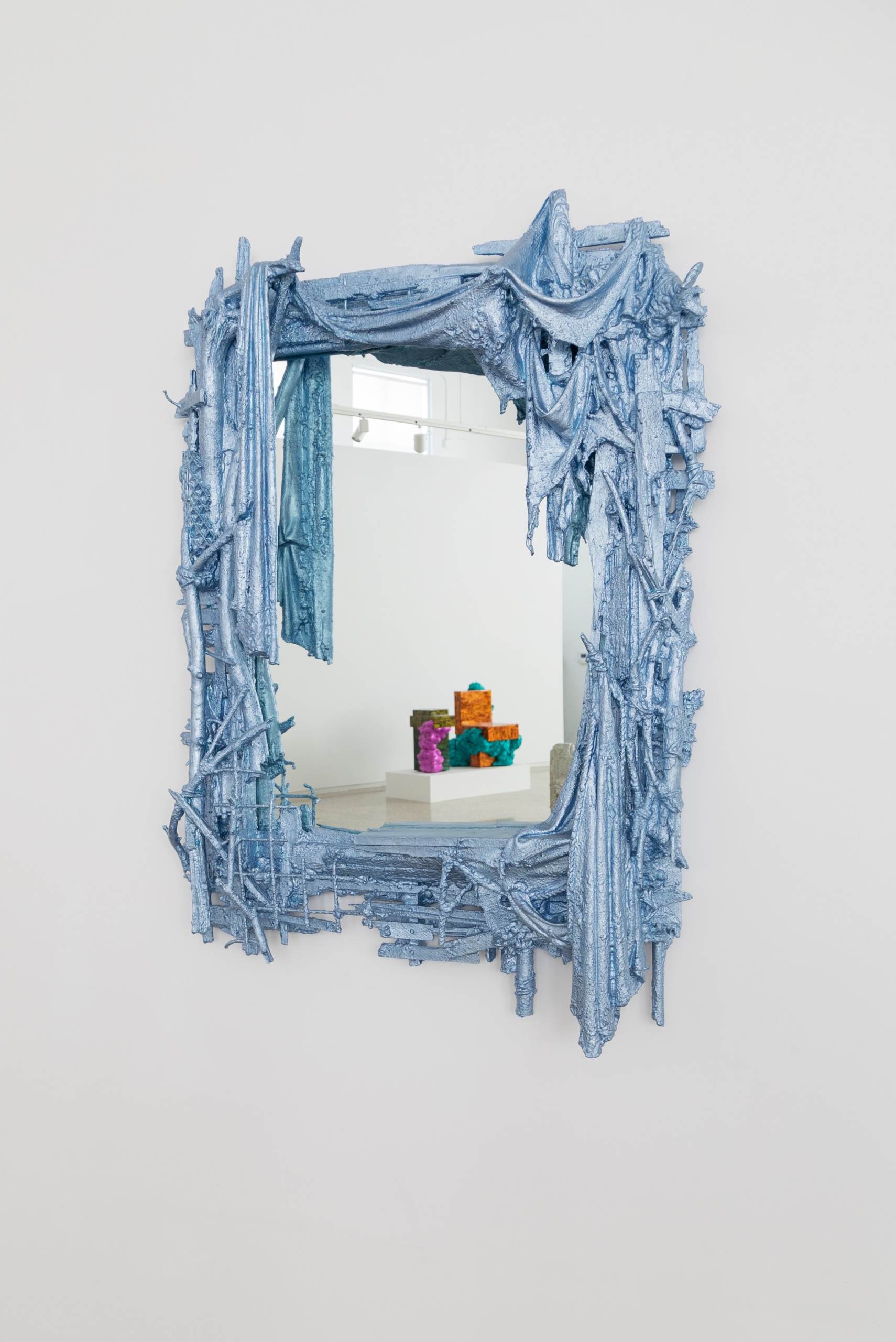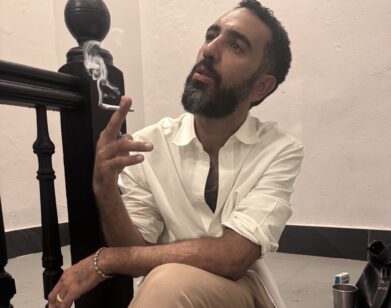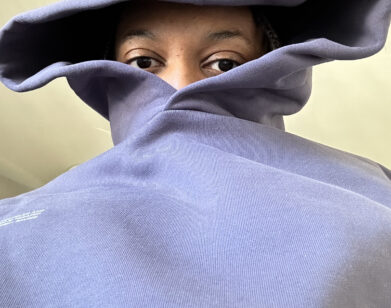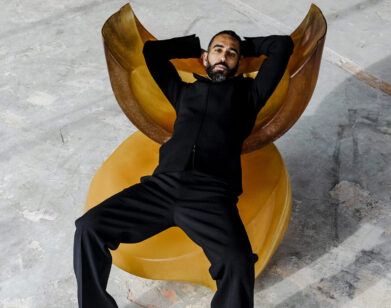in conversation
Artist Chris Schanck Wants to Transform Your Living Room Into Something Otherworldly

Photo by Michelle and Chris Gerard. Gallery photos by Clare Gatto. Courtesy of Chris Schanck and Reyes | Finn.
There’s a chair, and then there’s a chair. The former: perhaps a fold-out, perhaps a swivel, padded lightly with a cushion for sufficient orthopedic comfort. The latter, as imagined by the artist Chris Schanck: a day-glo wood block draped in fungal growth, an extraterrestrial body whose purpose is to take up space rather than to be its vessel. Schanck’s functional sculptures, which are now on display in his native city of Detroit as part of the exhibition Shuddering at Reyes Finn Gallery, would each complement one another in a living room, if you’re the type whose interior design proclivities include clashing colors, bulky shapes, and junkyard materials slapped together and transformed into something nearly incomprehensible, if not a bit scary. (Those people exist, and include Interview‘s very own Editor-in-Chief.) In addition to the “serpentine chairs,” there are “amoeba cabinets,” and aluminum foil night lights, each a reflection of the artist’s relationship to his home city and its ever-changing industrial landscape. The decidedly ugly and deliciously decadent result lies somewhere between an ’80s penthouse and a galaxy far, far away. To bring things back down to earth, Schanck got on the phone with the sculpture artist Nikita Gale to explore the meaning of home, and the catharsis in mentally throwing it up. —SARAH NECHAMKIN
———
CHRIS SCHANCK: Are you in L.A.?
NIKITA GALE: I‘m in L.A. Are you in Detroit right now?
SCHANCK: Yeah. It’s still light there.
GALE: Yeah. I mean, I’m three hours behind you. I always forget that Detroit is Eastern. You’re in the future always.
SCHANCK: We’ll go slow. The audio delay feels like we’re on walkie-talkies.
GALE: It’s exactly like that. Where to start? We haven’t actually met, right?
SCHANCK: No, we did. We met in Miami for like two minutes. You were showing at NADA, and I made these massive day-glo piñata-type sculptures for a party on the beach. You came to it.
GALE: Oh my god. I totally remember that. So we’ve met briefly, but we didn’t meet in Detroit. Speaking of Detroit, I want to talk about your show. One place where I wanted to start was with family. You worked on a piece with your mom, is that right?
SCHANCK: Yeah, we made a chandelier together. It’s something that I wanted to do for a long time. My mother Carol is naturally gifted and she was my first art teacher in the home growing up, my first creative mentor. When I was really little, and I couldn’t draw something that was too difficult, I would take it to her for help. That was the beginning of us working together. But as I got older and better, I stopped going to her for help. My practice got further and further away from what she even recognized as art, and that started to bother me.
GALE: Sounds familiar.
SCHANCK: This beautiful thing that once connected us was now dividing us. So I wanted to do a collaboration with her to reconnect that part of our relationship we lost so many years ago.
GALE: I love that. You talk about this point, a moment when your work started to kind of diverge from a point of understanding for your mom. What were you making that caused that response?
SCHANCK: I was an undergrad at SVA and my work inevitably became more conceptual as the city and what I was seeing in the art galleries at the time started influencing me. I stopped painting and traditional object-making and started working with a lot of found objects and borrowed art from my peers’ studios. I’d collage the borrowed work combined with found objects to make temporary installations. I was curating and collaging with what was on hand. Come to think of it, that sounds a lot like my mother’s process.
GALE: Well, it’s this interesting combination of pulling from these different disciplines, whether it’s sci-fi or design, furniture design especially. I think that’s an entirely different but really interesting language. I don’t think it requires that much explanation in the beginning to understand, like, “this is a chair.” This is a universal object or symbol.
It functions like an infrastructure in the same way that you were working with your mom. You’re creating this infrastructure that she then builds on top of. There’s something about playing around with this universal language, or this universal object of the chair, and sort of building on that.
SCHANCK: That’s one of the strengths of furniture. We all have a familiarity or archetype in our head that you can relate to, and we’re all experts in sitting on chairs and toilets. The objects are grounded in that common understanding and then they grow out from there.
GALE: I think as a viewer too, you have a very embodied, sort of unconscious relationship, to those objects. The scale still relates to your body. Then there are these additional decorative elements that also shift that experience of your body in the presence of this familiar object.
SCHANCK: That makes me think of my grandmother. She was really ill and my mother was taking care of her in our home. The hospital issued her a standard wheelchair, stainless steel with artificial black leather. It was just so cold to her, and my grandmother refused to sit in it. So my mother went to it with her hot glue gun, ribbons and lace.
GALE: No way.
SCHANCK: She hot glued it and sewed on an explosion of pink ribbon and lace, turning the chair into a fairytale. My grandmother embraced it after that.
GALE: That’s amazing.
SCHANCK: That’s this perfect combination to me of your emotional and physical wellbeing coming together. I want a work to address the needs of your body and your heart.
GALE: This is also something that comes up in your work: the innate human desire for seeking out comfort or warmth. There’s this idea of landscape, seeking comfort within the landscape. Seeking out these moments of transformation that could lead into an idea of comfort or warmth.
SCHANCK: I do think about caves quite a bit. I began by looking at ancient geological formations that would occur in a type of ancestral dwelling or home, like a cave. Looking at those formations within that environment, I classified them as early examples of interior design elements. Think like stalactites or stalagmites as decoration in the cave. Then I hypothesize a Jung-like genetic memory of having lived in those spaces, passed down over millennia to us now. If I could take that ancient memory and introduce it into a contemporary domestic landscape, with the intention of introducing something from our own strangely familiar past into our everyday lives. Possibly that strangely familiar ancient memory is a comforting thought.
GALE: You’re thinking about your neighborhood, or your engagement with that space—the engagement between that space and your studio, and what comes out of that process.
SCHANCK: I started looking at my own neighborhood and making work about where I am from a desire to feel connected to where I live. The landscape of our community is unique to this place and the texture and attitude towards material here has been a big inspiration.I’m grateful to live in a community for the first time where I know my neighbors. My studio started in my home. My first assistants lived across the street and we worked out of my house for the first five years.

GALE: I love it.
SCHANCK: It was a very open, porous border between the house and the neighborhood. It all sort of spilled in. I was growing my work and the practice at the same time as learning about where I was living.
GALE: How long have you lived there? When did you move?
SCHANCK: I moved down here in 2011 after I graduated.
GALE: So almost a decade.
SCHANCK: The work was growing as we were all learning this process together. There’s a material culture here that is unique to this little corner of the world. You can see the generational handiwork that’s gone into repairing homes and mending fences, and creating space over time. There’s also a huge gardening community here that’s inspired a lot of my work. Folks here collect and gather materials from an adjacent property, and bind and lash and tie them together to form these intuitive gardening infrastructures that will graft onto an existing piece of architecture building. These assemblages become frameworks and infrastructure for growing fruits and vegetables.
It’s inspiring to see all these disparate elements that are tied together in these intuitive but elaborate ways that first looks like chaos and doesn’t look intentional. It took me time to understand how much purpose was behind all of it. That I was in this landscape that was so carefully constructed, and nothing was going to waste, and everything was being reanimated in a different way. I became inspired to look at my relationship between myself and the material in my landscape. What we have is what we have. I wanted to know where I lived and the place I lived in. I think I understand the world best through materials and processes.
GALE: That’s a really fascinating response. It’s again bringing me to this idea that you brought up when you were talking about the cave. This idea of a sort of common denominator, or these ancestral ties to previous modes of making. I think about these material investigations, or these moves that you often see in especially working-class neighborhoods. People are basically just using whatever materials they have on-hand, but using them in very meticulous, methodical ways. I think a lot about the history of barricade construction, how that in mid 19th-century France, barricades were just garbage basically, parts of the streets and roads that people were ripping up to create these blockades within cities. It’s improvisational, but it’s all sort of coming from the same place.

SCHANCK: I’m just imagining. Like Les Mis. Jean Valjean.
GALE: The forms of the original materials are transformed, and then take on these new uses.
SCHANCK: It’s interesting what you say. I think there’s a similar thing that happens in our neighborhood, these barricades of trash you’re talking about. Every spring and summer here, these massive piles of furniture and old products pile in these heaps in front of people’s homes. They pop up all over the neighborhood. You can see the personality in the person who’s putting these piles out. Some are haphazard, some are very carefully laid out as though they know someone will come through picking through it. For a long time, I saw these piles as garbage. It was like, “Ah, another pile of garbage on the corner.” Waiting for it to be gone. Then I realized, there’s something else going on here. There has to be.
There’s a story of these things that lead up to them getting to this point, and the people behind them. So instead of seeing these things as piles of garbage, if I could see them as symbolizing things in transition. There’s an old mattress and an old set of dining chairs. I could optimistically think, “Well, they’ve cleared out the old stuff and made room for better things. Maybe there’s upward mobility in the home. Maybe things are improving.” Or, “They’ve been evicted, and everything’s had to go out on the corner. They’ve moving out, and everything has to get left behind because there’s no room where they’re going.” I don’t know, but something is happening. Something’s changing. It’s not garbage. It’s someone’s life that’s going through a transformation. That means something. It carries some energy from its past life. It’s already imbued with a history and power, a residual energy.
- “Serpentine Chair,” 2020. Wood, polystyrene resin, aluminum foil.
- “Nite Light: Xenorc,” 2019. Aluminum foil, found objects, glass, resin, steel.
GALE: The archeologist in my brain is feeling really, really… It’s a really provocative statement that you’re making. You’re talking about interpreting or building out meaning based on artifacts that people are leaving outside of their homes. Archeology as a practice is very contextual, but it’s also very speculative in terms of the leaps or assumptions that you have to make to piece together these narratives. What does it mean that this object is here, and not somewhere else, like outside of the house versus inside? What prompted that transition?
SCHANCK: Looking at the home from the exterior in this neighborhood, for example. You can see a layering of technological innovations over time. In the literal landscape of the rooftops across the neighborhood, all the old antennas for television for example.
GALE: Oh, wow.
SCHANCK: Instead of the old technologies being stripped away, they just get layered and layered. You can see the time, the layers in the stone.
GALE: The stratification.
SCHANCK: It’s technological stratification. It’s layers on top of layers, lives on top lives. You can almost see these narratives playing out over time by examining the exterior of the home. You can start to imagine the lives lived inside. There’s something about that that draws me in. I’m always wondering about the lives of others.
GALE: We started out talking about your mom. I want to know more about this.
SCHANCK: My family is really influential to me.
GALE: We can’t escape them.
SCHANCK: I just spoke with my dad today and we had a really strange conversation about growing up.
GALE: About what? Well, we don’t have to get into it. I’m all ears though.
SCHANCK: I’ll tell you this story quickly. I was thinking about process and repetition in my work, and I wanted his help recalling a memory of delivering newspapers with him. He would deliver newspapers seven days a week when I was growing up. He did this in addition to his day job. Every day, he was up at 4:30am to go and do the papers. On the weekends, my sister, brother, mother and I would go with him. By 5:00 a.m. we’d meet all the other paper delivery people at the strip mall parking lot, and that’s when the trucks would come with the newspapers and just drop off these massive pallets of newspapers. My dad warned me and my sister, “You’re going to get really sick, but then it will be okay.” We were like, “What do you mean?” He’s like, “You’re going to throw up, but then you’ll be okay.” We were defiant. “We’re not going to throw up. We’re not going to get sick.” We thought we were so tough, but sure enough, about an hour after working, the scent of the ink became so powerful it would make you incredibly nauseous and you’d puke your guts out.

Left: Shuddering Chair, 2019. Right: Shuddering Table, 2019.
GALE: Whoa.
SCHANCK: But then you were fine, just like he said. You just had to get it outta your system. After the first few weekends of getting sick you become immune and then it’s all downhill. I hadn’t thought about that memory in a long time, but I still relate to it. It makes sense in a creative process. There’s this uncomfortable period. You have to get past the mental throwing up, and then get in the groove.
GALE: Yeah. To create something new there has to be some kind of discomfort or destruction. Then the process of healing or acclimating allows you to continue moving forward.
SCHANCK: It’s got to hurt something or break something. You have to mentally throw up or purge old ideas. It can’t be easy, or painless.








